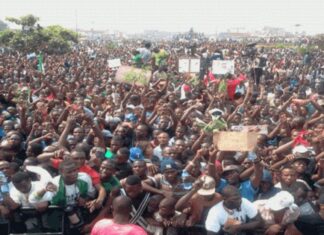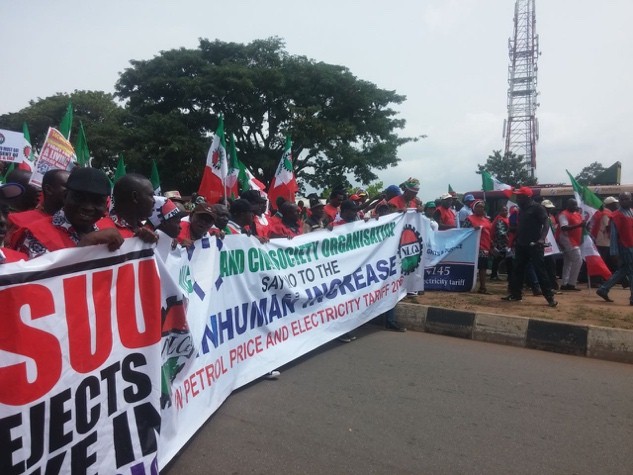 The tenth general strike in Nigeria since 1999 was recently ‘suspended’ by the Nigeria Labour Congress after five days. The strike was against the most recent rise in the price of petrol by almost 70% announced by the government. However, this was only the straw that broke the camels back.
The tenth general strike in Nigeria since 1999 was recently ‘suspended’ by the Nigeria Labour Congress after five days. The strike was against the most recent rise in the price of petrol by almost 70% announced by the government. However, this was only the straw that broke the camels back.
Over the last decade the GDP of Nigeria has almost doubled, but all of this wealth has been taken by the corrupt rich elite of the country. As a result, the richest person in Nigeria, Dangote is also the richest person in Africa and is richer than anyone in Britain. In addition, the 12 richest Nigerians would be amongst the fifty richest people in Britain.
A new government was elected in March 2015 and the new President, Muhammadu Buhari, took office in May last year. He had promised to fight corruption and use the funds to significantly increase the funding for education and health; and provide a merger £10 a month to the poorest 25 million people in Nigeria. However, in reality the government has made the poor significantly poorer this year.
In January, the price of kerosene (the cooking fuel of the urban poor) was increased by 66%. Then the price of electricity was increased by 45%. Devaluation of the currency has also led to a spiralling of inflation – although officially still less than 15%. Food prices have increased by at least 50% this year. In contrast the minimum wage and public sector wages have not been increased for the last five years – and the minimum wage is less than £40 a month.
As a result, the National Executive Council of the NLC quickly agreed to a general strike – the traditional response to an increase in fuel prices – on Friday 13th May. The strike then started on Wednesday 18th May and daily demonstrations and protests were organised in all the major cities across Nigeria for the following three days.
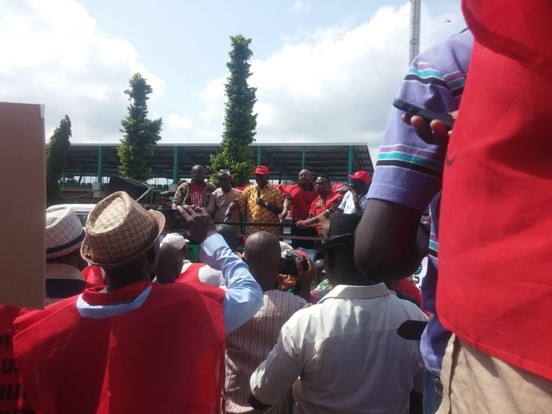
The last general strike in January 2012 was a near national uprising and succeeded in significantly reduce the increase in fuel prices. In contrast, this time there is little or no prospect of the increase in the price of petrol being reduced.
One key issue this time was the disunity in the trade union movement. The second trade union centre, the Trades Union Congress, soon backed out of an agreement to strike. In addition, since March 2015 a few unions have broken away from the NLC. Despite now only consisting of four of the NLC’s 43 member unions the mass media just refer to the two factions of the NLC as if they had equal weight. The unions that have split from the NLC, and crucially the two unions for the oil workers, also refused to join the strike.
Another issue was the level of preparation and organisation for the strike. The leadership of the NLC spent the final two days before the strike in talks with the government rather than arranging for meetings at all levels across the labour movement.
Below we provide brief reports of the strike in some parts of the country from SWL members who participated actively there.
Lagos
The general strike was not too encouraging as the strikes have not been effective – there is a lack of trust in the NLC. It needs massive propaganda to gain support for the strike. The split from NLC by Ajaero and a few trade unions has been important.
On day one the protest was marvellous and caused serious grid-lock along Ikorodu Road on the way to the airport. The workers occupied Government House in Ikeja on Thursday and Friday. “Even if the strike is called off by Monday it is okay”. The question of the minimum wage should have been linked to the petrol price increase
Ibadan
The protest on Wednesday was very big. Some workplaces were barricaded, but some banks remained open and vehicles were on the roads. The strike was effective in the civil service. Public schools were closed, but the public hospitals were considered essential services so continued to provide care for the public – but this was only by senior staff as the junior staffs took part in the general strike. Socialist Worker was sold on the protests. TUC members were on strike, but returned to work on Thursday and Friday.
In 2012 the APC supported the general strike. This time many people hope that the government of change will provide something for the working class. Before the price hike the black-market price of petrol had been around £0.25 and then was available at the new increased official price of £0.29.
The split away from the NLC by some trade unions led by Joe Ajaero of the electricians’ union has been key to the lower level of support for this general strike. Unity is needed to ensure future protests are effective.
Osun State
NLC members, the Joint Action Front (a campaigning body) and students of the Obafemi Awolowo University (OAU), Ile–Ife continued the peaceful protest, urging residents to reject the 145 Naira petrol pump price.
Commercial and other related activities in the ancient town went on as the protesters blocked the popular Lageere Roundabout, causing traffic for few hours.
The workers comprising basically of members of the Academic Staff Union of Universities (ASUU) and the Non-Academic Staff Unions of Universities in OAU, moved from the campus to Mayfair roundabout, distributing flyers to motorists and people on the street.
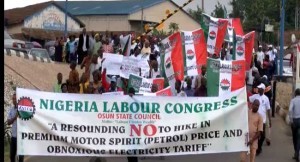
Kaduna
The NUT is on strike but the private schools are still open. The health workers are also on strike.
The state government has threatened to sack 15,000 workers from the state and local governments. During the strike it ordered all workers to register as they came to work each day. Workers were worried that those who went on strike would be chosen for dismissal.
Kano
We are having trouble with the state security and they police as they are saying that protests cannot be held because of the danger of Boko Haram. But on Thursday the Kano Civil Society Forum organised a protest and about 30 people attended. KCSF met again on Sunday afternoon to consider the next steps and how to mobilise the students as the University lecturers are on strike.
Civil society have also met with the NLC but they do not seem to be ready to lead the protests. On Wednesday KCSF met with ASSU (the lecturers union) and they managed to appear on the radio stations.
A protest was held, in support of the petrol price increase by a few hundred youths, civil society organisations and civil servants. They were claiming that the NLC is anti-Buhari (the president) and supporting the PDP (the opposition party that rule Nigeria for 16 years until May 2015).
Jos
The NLC Chair, Jibrin Bancir, and a member of the Civil Liberty Organisation, Steve Aluko, said that the union had continued to monitor proceedings at the state and the government offices where the entrances were locked.
However, secondary school students were going about their studies, as the TUC were not part of the ongoing strike with only the primary schools under lock and key.
Benin City
NUT members were on strike and some of the private schools were closed. Comrades sold Socialist Worker on the protests that were held each day.
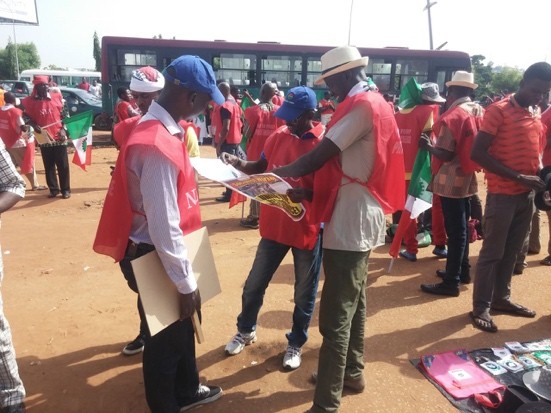
The banks were open and transport still operated so people were able to move around. Compliance with the strike was not absolute and the protests, although they were held every day, were significantly smaller than in 2012.
It is a dicey situation and the NLC must have resilience or they will become weaker.
Calabar – a major city in the south east
The strike is very strong and the private sector companies and banks have joined the NLC strike. Some banks in Calabar were closed Friday after the NLC posted notices calling on the workers to go home. The leadership of the NLC in the state accompanied by some state and federal workers on Friday continued its march through the major streets in Calabar to register their protest. Government offices and public schools remained shut.
The NLC had on Thursday gone round markets in Calabar urging them to shut down. Led by its chairman, Comrade John Ushie, markets visited included Watt, Etim Edem, Bedwell, Chamley and Bogobiri.
Lokoja
Turnout for the protest was poor on the first day, Wednesday, barely 100 people attended and it was a worse on the second day. But by Friday, the mood had pciked up and there was a higher turnout for the demonstration, which marched through major streets of the city.
One of the problems for the earlier poor showing is that the petrol situation has actually improved. Before the price increase people were paying about N200 a litre on the black market, thus N145 per litre appeared to be a better deal. But the NLC redoubled its mobilisation.
It could however have even won more support if it had linked the petrol price increase to the following problems:
- high salaries and allowances for politicians and their advisors
- non-payment of five months salaries owed workers by the state government.
Abuja
All the attacks of neoliberalism should be linked with the general strike. The price increases for kerosene, electricity, food (tomatoes increased by 25%, bag of rice almost doubled in price etc), the failure to pay workers salaries in 32 of the 36 states and the failure to increase the minimum wage for six years.
The NLC leadership spent far too long talking to the government on Monday and Tuesday, the two days before the strike was due to start – rather than mobilising the members and having sensitisation meetings at all levels.
The NLC NEC met on Tuesday evening and so many delegates could not return to their states until Wednesday morning. This meant that mobilisation started very slowly and many of the workers did not know whether the strike was actually going to go ahead on Wednesday morning.
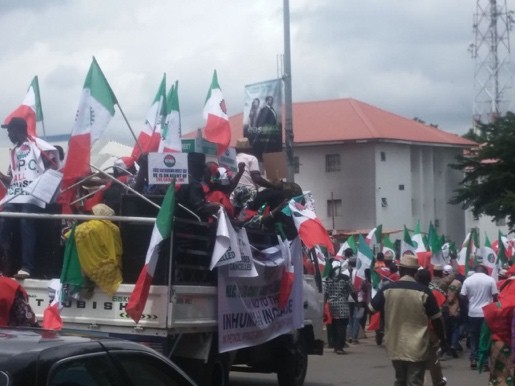
Even in Abuja, little action was taken until Friday when the NUT task force finally managed to close a number of primary and secondary schools.
On Wednesday morning, the first day of the strike the NLC allowed office workers to enter Labour House (its office block) to work (although they were required to leave before 9 o’clock).
Wabba, the NLC president said, “even if we are few we have to be on the side of the workers,” and “today we will mobilise, tomorrow will be better and stronger”.
The protest finally left Labour House at 9:45am and marched to the Federal Secretariat. Here it was realised that many of the workers had gone to work in the government offices. But nothing was really done to try and encourage the workers to come out and join the strike and protests. Apart from a few fine words from the NLC leadership and Issa Aremu (who had originally supported the split from the NLC). The protest then marched through Wuse and ended at Berger Bridge (a major junction and entry point for workers commuting into the city).
On the second day the protest started at Berger Bridge and was about the same size with about 500 protesters. ASUU and SSANU joined the strike on the second day, so at least some of the universities were closed. The protesters walked down Nnamdi Azikiwe Expressway and ended up at Garki Area 1 (a popular area). There it met a small protest by some youths who waved brooms and chanted pro-Buhari slogans.
SWL members intervened in the strike engaging in discussions with workers. A good example was a branch chair of the Nigeria Civil Service Union. While he was active in the demonstration on Wednesday, he regretted the fact that workers in his office, most of whom are members of the Association of Senior Senior Civil Servants (an affiliate of TUC) as well as some members of his union did not join the strike. He was encouraged to convince them to join.
After the demonstration on Wednesday, he went back to his office and called a union meeting. He successfully argued for all NCSU members to join the strike. We met him again on the Friday demonstration and he said that almost all the workers in his office had remained on strike and 10 of them had joined the protests that morning. He bought a copy of the Rebels Guide to Lenin and sat down and read the pamphlet while waiting for the protest begin. He told us that it was a very good pamphlet.
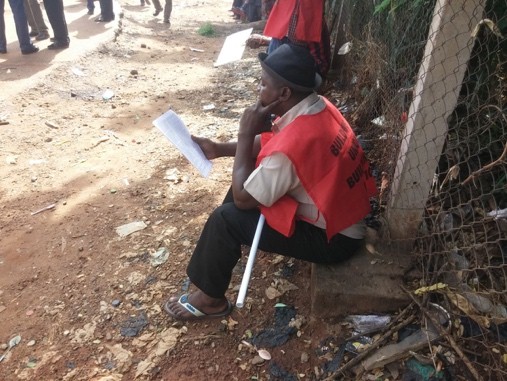
On the third day, Friday, the protest in Abuja was significantly larger and later on was joined by a number of students from colleges and polytechnics. The president and general secretary of the NLC only stayed a short while at the commencement point of the rally before leaving to meet with a delegation at Labour House. But they later joined the procession at the end point, which was he Unity Fountain.
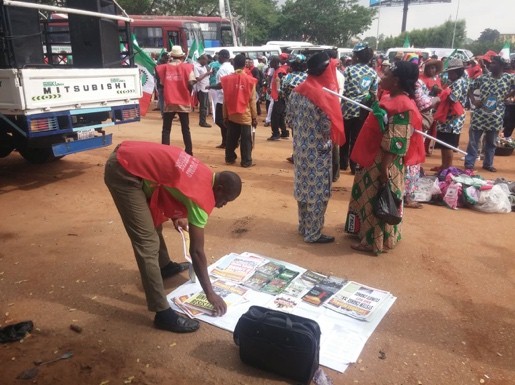
The demonstration again went through Wuse and ended up at the Unity Fountain near the Transcorp Hilton Hotel. Here Wabba announced that the delegation had been Tinubu (the leader of the government party and known to be very corrupt), the senator for Kano North and the governor of Osun State. The delegation had called on the NLC to end the strike and return to the negotiating table. At the end of the protests on Friday, the NLC president called on everyone to meet again at Berger Bridge at 7:30am on Monday morning.
by Tina Ndi








